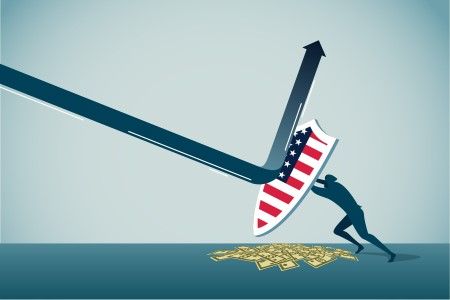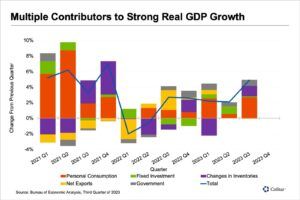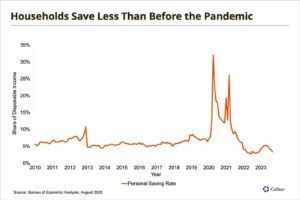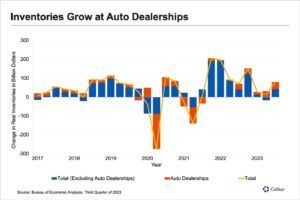The Economy Rolls Along, Posts Strongest Growth in Nearly Two Years

The Economy Rolls Along, Posts Strongest Growth in Nearly Two Years |
| Instead of slowing during the second half of the year as many economists had predicted, economic growth is accelerating. The Bureau of Economic Analysis reported last week that real gross domestic product grew by 4.9% annualized during the third quarter, easily beating expectations. For the Federal Reserve, which remains committed to bringing inflation back to its 2% target rate, the report might suggest that rate hikes and balance sheet reductions have so far not had their intended impact on economic growth — or that the lingering effects from pandemic-caused imbalances might take more time or more extreme measures to resolve. The bureau’s report showed that consumer spending grew by 4.0% (annualized) in the third quarter after adjusting for inflation and contributed 2.7 percentage points to real GDP growth. As we noted a few weeks ago , the consumer may have a longer runway than previously expected because the estimated bulk of pandemic-era savings was found to be larger than earlier estimates after the bureau’s data on personal income was revised. Today’s consumers appear willing to spend more and save less, according to a separate bureau report showing consumption growth outpacing income growth, causing the savings rate to fall to 3.4% in September, its lowest rate since December 2022 and well below the five-year pre-pandemic average rate of 6.2%. Business investment contributed just 0.2 percentage points to real GDP growth in the third quarter. The rise in interest rates and slowing demand might have weighed on residential construction this year, but this sector saw a 3.9% annualized gain in the third quarter, its first gain since the second quarter of 2021. Construction of nonresidential structures continued to increase for a fourth consecutive quarter, although slowing from robust growth earlier in the year to gain 1.6% annualized in the third quarter. This sector has benefited from investment spurred by federal funding and other incentives made available through last year’s Chips and Science Act and the Inflation Reduction Act. Inventories, meanwhile, which include materials, supplies, and unfinished goods, increased in the third quarter and contributed 1.3 percentage points to real GDP growth. While the final goods and services that these inventories produce won’t be consumed until future quarters, GDP accounting practices count them towards economic output in the third quarter. When these items are consumed in the future, they will represent a drawdown of inventories and be a drag on real GDP growth if they are not replenished. Half of the contribution from changes in inventories was from motor vehicles and parts, which is not unusual as inventories in this sector have been growing. Persistent supply chain disruptions have prevented auto dealerships from restocking inventories for months and caused shortages in certain makes and models. The recent growth in inventories has helped dealers to finally fulfill existing auto orders, but sales in general remain far below pre-pandemic levels. The last component to contribute to economic growth in the third quarter was government spending and investment, which contributed 0.8 percentage points to real GDP growth, about half of which came from federal sources and the other half from state and local governments. Government spending has been a positive contribution to real GDP growth for five consecutive quarters, largely supported by the Bipartisan Infrastructure Law adopted in 2021 that allocates $1.2 trillion towards infrastructure-related spending over multiple years. What We’re Watching …How long can we expect consumer spending to last? The spending spree has to ease off eventually, as real disposable incomes have been falling for four consecutive months. Wage gains have been slowing and are projected to slow further as the labor market weakens, although we’ve frequently been surprised at the enduring resilience shown by the job market. Consumers themselves are turning pessimistic in their outlook. The Conference Board’s consumer confidence index fell for the third consecutive month in October as inflation concerns, higher gasoline prices and expectations of future economic conditions all worsened. Moreover, higher credit card rates and the resumption of student loan repayments have led to an increase in interest expenses for consumers over the past few months, which are now 48% higher than a year ago, cutting into household budgets. At some point, consumers will likely be squeezed enough to finally close their wallets. CoStar Economy is produced weekly by Christine Cooper, managing director and chief U.S. economist, and Rafael De Anda, associate director of CoStar Market Analytics in Los Angeles. |
The post The Economy Rolls Along, Posts Strongest Growth in Nearly Two Years appeared first on Alterra Real Estate Advisors LLC.












Share On: